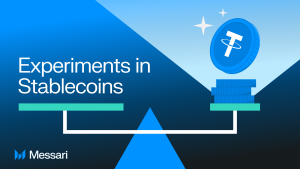Key Insights
- Arbitrum has announced plans for the ARB token and initial plans to roll out the Arbitrum DAO. The DAO will distribute nearly 12% of the ARB supply to Arbitrum users to be claimed on Thursday, March 23.
- Arbitrum’s governance is built around a series of on-chain governance contracts spanning Ethereum Mainnet, Arbitrum One, and Arbitrum Nova.
- The launch of the Arbitrum DAO introduces several new governing bodies, including the Arbitrum Foundation, a Cayman Islands company, the Security Council, and the Data Availability Committee.
Introduction
On March 16, 2023, Arbitrum announced the establishment of the Arbitrum Foundation, along with the governance of the Arbitrum One and Arbitrum Nova networks through a decentralized autonomous organization (DAO) and the highly anticipated Arbitrum governance token (ARB). Initially developed by Offchain Labs, the release of the Arbitrum DAO Constitution clarifies the guiding principles, organization framework, and procedures. The constitution will be used to govern the Arbitrum DAO Treasury, the contracts and parameters for Arbitrum One and Arbitrum Nova, and the DAO Governance contracts.
Arbitrum is a suite of technologies developed by Offchain Labs that are designed to scale Ethereum. These solutions include the optimistic rollup protocol, Arbitrum One, and an Arbitrum AnyTrust Chain Arbitrum Nova. These networks aim to enable faster and cheaper transactions than on the Ethereum mainnet.
Airdrop
The long-awaited ARB token will be distributed among community members, native DAOs, the core team, and early investors. Those who qualify as an “Arbitrum user” before the Snapshot taken on February 6, 2022, are eligible for the airdrop. Airdrops will be claimable at block #16890400 or at approximately 7:33 a.m. (GMT) on Thursday, March 23, 2023.
The airdrop eligibility is determined by a points-based system that allocates ARB according to a user’s actions on Arbitrum One and Arbitrum Nova. Users can earn one point for each action item completed, up to a maximum of 15 points. The eligibility criteria for the airdrop encompassed many actions on both the Arbitrum One and Arbitrum Nova chains.

Most of the scoring criteria focused on Arbitrum One, presumably to incentivize early adopters. However, additional criteria also included Arbitrum Nova users, allowing them a maximum of four points or a single extra point on top of their Arbitrum One rewards. Additionally, points scored on Arbitrum One before the release of Arbitrum Nitro are worth twice as much.
Distribution
Arbitrum’s ARB token has a total supply of 10 billion and a maximum annual inflation rate of 2%. One unique aspect of Arbitrum’s airdrop is its allocation to the Protocol Guild, a collective of 130 Ethereum contributors. In doing so, Arbitrum elected to reward not only DAOs within its ecosystem but also contributors on Ethereum L1. While Optimism mapped out a plan to give back to the ecosystem via retroactive public goods funding, Arbitrum elected to do so by airdrop allocation.
The distribution of ARB is as follows:
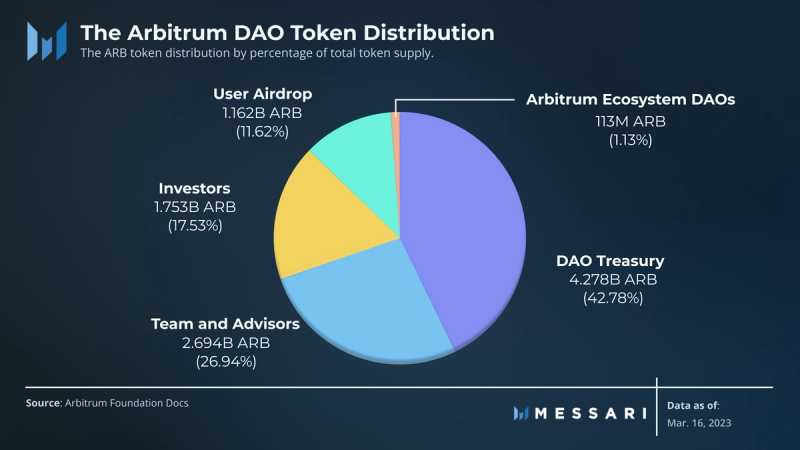
While the DAO treasury will receive ~4.3 billion ARB, the true number of DAO-controlled tokens will be closer to 3.5 billion when AIP-1 is ratified. The proposal outlines an immediate plan to create an “Administrative Budget Wallet” controlled by the Arbitrum Foundation and fund it with 750 million ARB (7.5% of the total supply). The wallet will be used to allocate special grants, reimburse the Foundation’s total setup costs ($3.5 million), and fund ongoing administrative and operational costs.
Governance Structure
The Arbitrum DAO governance structure comprises several entities with different levels of authority.

(Source: Messari Governor)
The Arbitrum DAO
The Arbitrum DAO is governed by ARB tokenholders using the Arbitrum governance contracts, which exact control over the following assets:
- the Arbitrum DAO Treasury,
- Arbitrum One contracts and parameters,
- Arbitrum Nova contracts and parameters,
- and the Arbitrum governance contracts.
Arbitrum tokenholders can propose, vote on, and effectuate on-chain proposals using Arbitrum Improvement Proposals (AIPs). AIPs have several functions including, adjusting parameters, assigning new permissions and chains to the purview of the DAO contract, distributing funding, and providing information or guidelines to the community and DAO.
The Arbitrum Foundation
The Arbitrum Foundation is a Cayman Islands company bound to the rules of the Arbitrum Constitution. It serves the Arbitrum DAO community in order to foster the growth and development of the Arbitrum ecosystem. The Foundation is governed by the Arbitrum DAO. Following the approval of AIP-1, the DAO may remove or elect the Arbitrum Foundation’s directors and adjust the number of directors at any time
The Foundation is responsible specifically for overseeing the fiduciary responsibilities of AIPs and ensuring AIPs do not violate the Arbitrum Foundation’s Amended & Restated Memorandum of Association, the Arbitrum Constitution, or breach of legal contracts or arrangements.
The Foundation is additionally empowered to issue grants using the Special Grants process. Special Grants is an on-chain, permissioned application process which allows the Arbitrum Foundation to issue grants from the Administrative Budget Wallet without undergoing the Arbitrum Improvement Proposal (AIP) process.
The Security Council
The Security Council oversees an elected 12-member multisig wallet empowered to perform emergency and non-emergy actions. The Security Council is authorized as an emergency backstop and a routine operational council.
The Security Council can perform an emergency action with 9-of-12 approval. It would then be able to execute any software upgrade or required action to protect the integrity, confidentiality, or availability of an Arbitrum DAO chain. After performing an emergency action, the Council must publish a full transparency report.
It can also perform a non-emergency action with 7-of-12 approval to implement routine software upgrades, maintenance, and parameter adjustments in a non-emergency setting. These actions allow the DAO to bypass the voting stages of an AIP to the L2 waiting period.
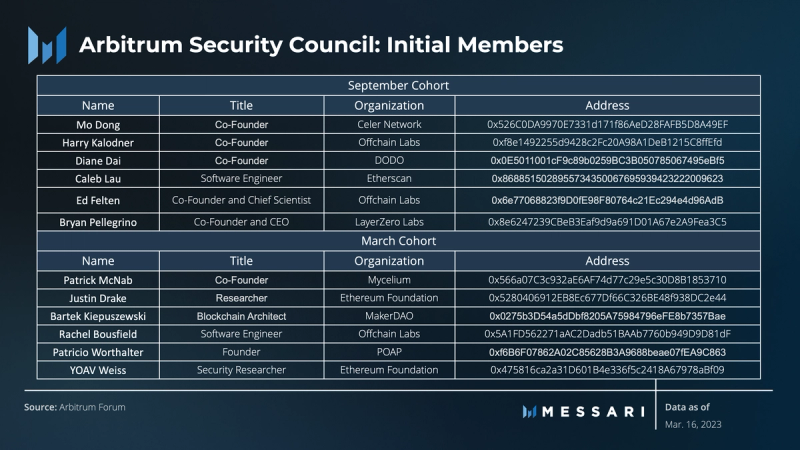
The Security Council comprises 12 members divided into two 6-member cohorts elected each year on March 15 and September 15, respectively. Each member is compensated $5,000 per month in ARB tokens. AIP-1 proposes the 12 initial members of the Security Council.
Security Elections will be conducted every six months by the DAO via an ARB token holder vote. At any point, Security Council members are subject to removal before the end of their term with a ⅚ majority vote in favor of removal and a 10% quorum.
Data Availability Committee (DAC)
The DAC manages the data availability of Arbitrum Nova, an AnyTrust chain. The AnyTrust model relies on the DAC to store and provide data on demand. DAC committee members can be appointed or removed via a Constitutional AIP or if a committee member resigns without a replacement, appointed by an emergency action from the Security Council.
Governance Process
The initial governance process for the Arbitrum DAO has been published to the DAO forum under AIP-1. To begin, the DAO will have three different governance processes for varying proposal types: AIPs, Special Grants, and Security Council Elections.
Phases of Arbitrum Improvement Proposals (AIPs)
The governance process varies depending on whether the AIP is considered Constitutional or Non-Constitutional. While all AIPs will follow the same process in phases one through three, Constitutional AIPs will require additional periods of delay following the on-chain vote.
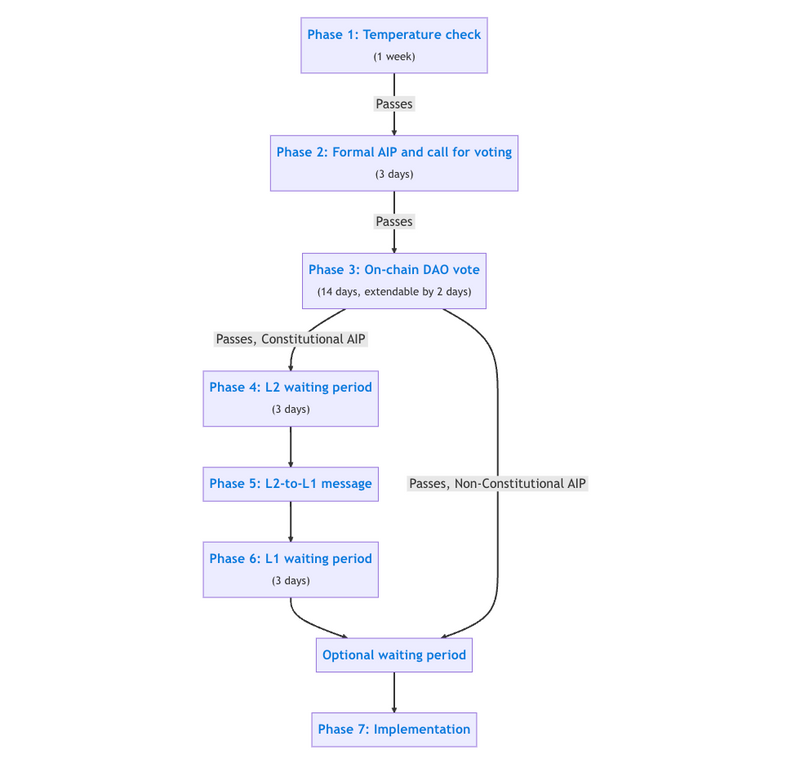
(Source)
Phase 1: Temperature Check — Constitutional + Non-Constitutional AIPs
New AIPs begin as a discussion posted to the Arbitrum forum, following the AIP template. The proposal should be discussed on the forum for at least a week. Each AIP must be labeled either “Constitutional” or “Non-Constitutional.” There are key differences between these types of proposals:
- Constitutional AIPs: 34-day implementation timeline.
- Process: Modifies the text or procedures of the Arbitrum Constitution (e.g., AIP 1).
- Software Update: Installs or modifies software on any chain.
- Core: Takes any action that requires the “chain owner” permission on any chain.
- New Chain Approval: Authorizes a new chain approved by the Arbitrum DAO. This includes both Governed Chains and Non-Governed Chains.
- Non-Constitutional AIPs: 21-day implementation timeline.
- Funding: Requests funds, grants, or otherwise proposes how to spend or allocate funds from the DAO treasury held by the Arbitrum Foundation.
After a week of discussions (minimum), the AIP should be moved to an off-chain vote in Arbitrum’s Snapshot Space. To create a Snapshot poll, the author must hold at least 0.01% of the total “votable” tokens. After one week, the Snapshot poll is decided by a simple majority vote with no quorum. To vote, members must hold or be delegated the ARB token.
Phase 2: Formal AIP and Call for Voting — Constitutional + Non-Constitutional AIPsAIPs that pass the off-chain temperature check become formal AIPs ready for an on-chain vote. The AIP is submitted via governance contracts on Arbitrum One, and DAO members can vote using the Arbitrum DAO’s Tally portal.
The proposer’s voting power must exceed 5 million ARB to create a proposal. After the proposer has posted a vote on-chain, there is a three-day waiting period before the vote goes live. This waiting period allows interested parties to discuss the proposal further and gather votes before the voter distribution Snapshot.
Phase 3: On-Chain DAO Vote — Constitutional + Non-Constitutional AIPs
Following the three-day waiting period, a voter distribution Snapshot outlines all voters and their respective voting power, and the AIP vote begins. The typical voting period lasts 14 days. However, if voting thresholds are reached within the last two days, the voting period will be extended by an additional two days.
For an AIP to successfully pass on-chain, it must receive more votes “in favor” than votes “against” and meet the required voting threshold, which varies by AIP type. Constitutional AIPs must receive 5% of all votable tokens “in favor,” and Non-Constitutional AIPs must receive at least 3% of all votable tokens “in favor.”
Following a successful voting turnout, Non-Constitutional AIPs can bypass Phases 4-6 and go straight to Phase 7 for implementation. Since Constitutional AIPs reflect network upgrades and other changes that could affect users’ funds, these AIPs go through an additional waiting period before implementation.
Phase 4: L2 Waiting Period — Constitutional AIPs Only
After a proposal has passed, it must go through an additional waiting period. This additional time is to allow dissenting people to make changes before the proposal goes into effect. Following this three-day waiting period, the AIP will move on as long as no issues arise.
Phase 5: L2-to-L1 Message — Constitutional AIPs Only
Following the three-day waiting period, a message from L2 to L1 indicates that the AIP passed. Once the message has been finalized on L1, which takes at least one week, anyone can redeem it to complete Phase 5. Signaling the results of the vote on L1 acts as a record of the changes on the Ethereum blockchain.
Phase 6: L1 Waiting Period — Constitutional AIPs Only
After the message is recorded on Ethereum mainnet, there is an additional three-day waiting period. This final waiting period ensures that any pending transactions have adequate time to finalize on mainnet before the AIP is implemented to avoid any negative repercussions.
Phase 7: Implementation — Constitutional + Non-Constitutional AIPsThe final phase of the AIP process consists of implementing the changes outlined in the AIP. AIPs can be implemented either directly on the Ethereum mainnet or via a transaction sent from L1 to one or more of the L2 chains governed by the Arbitrum DAO.
The Arbitrum Governor Contracts
Arbitrum Governance comprises numerous custom governance contracts, Gnosis Safes, and Arbitrum system contracts spanning Arbitrum One, Arbitrum Nova, and Ethereum Mainnet.
The primary actors of the on-chain governance system are the Non-Constitutional Governor Contract, the Constitutional Governor Contract, and the Security Council. Each Governor Contract is a derivative of the OpenZeppelin Governance Framework and exists independently on the Arbitrum One rollup, with ownership permissions over two independent timelock contracts.
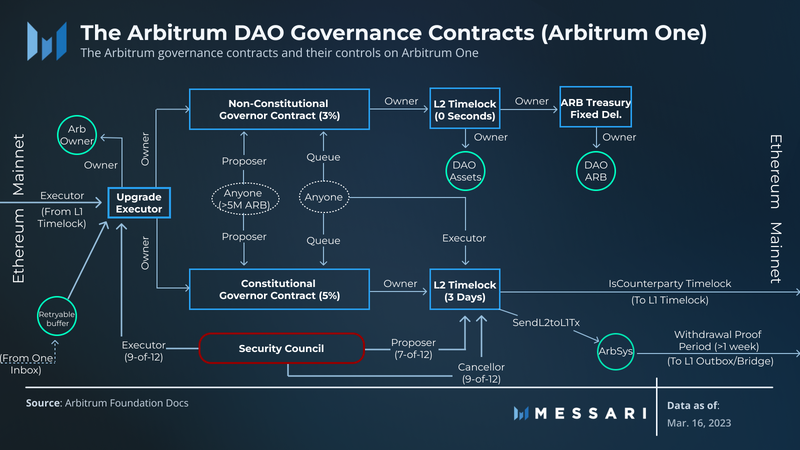
The Non-Constitutional Governor Contract only holds power over treasury-related proposals and controls contract ownership of DAO-held assets and DAO-held ARB. The Constitutional Governor Contract and the Security Council can propose directly to the L2 Timelock (3 days) contract, which passes those proposals to the L1 Timelock on Ethereum Mainnet.
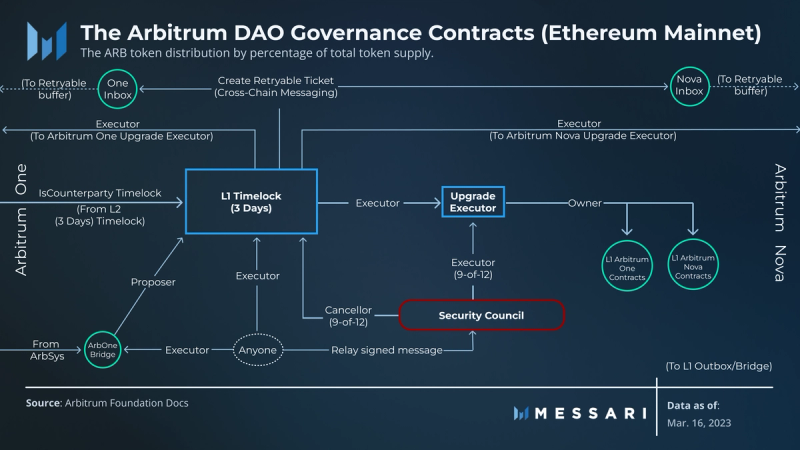
The L1 Timelock retains ultimate control of the Upgrade Executor for the Arbitrum One Governor Contracts, the ArbOwner contracts on Arbitrum One and Arbitrum Nova, and all Arbitrum One and Arbitrum Nova Contracts on Ethereum Mainnet. The L1 Timelock has further execution ability via a retryable ticket, which allows the L1 timelock to execute proposals via the Arbitrum One and Arbitrum Nove Upgrade Executer.
The Security Council also wields significant power to cancel proposals on the L1 and L2 3-day Timelocks and propose changes directly to the L2 3-day Timelock, effectively bypassing DAO governance. Although these kinds of multisigs offer a backstop against malicious attacks should DAO governance become compromised, they also introduce a key vulnerability, given the possibility for cartelization amongst the twelve signers.
Two Approaches to Layer-2 Governance: Optimism and Arbitrum
The Arbitrum DAO launch represents the second major Ethereum rollup to rollout governance. Optimism was the first layer-2 protocol to release a governance token and formally announce its decentralization roadmap.
The token distribution between the Optimism Collective and the Arbitrum DAO has some notable differences. While Arbitrum allocated fewer tokens towards user airdrops and more towards Core Team members and advisors, Optimism’s emphasis on Retroactive Publics Goods Funding is the largest distribution difference. While Optimism’s bi-cameral approach to governance is innovative, it puts an extremely large portion of OP tokens in the hands of relatively few decision-makers. In contrast, Arbitrum’s distribution placed nearly twice as many tokens under the purview of tokenholders, with nearly half of all the distributed tokens going to the DAO treasury.
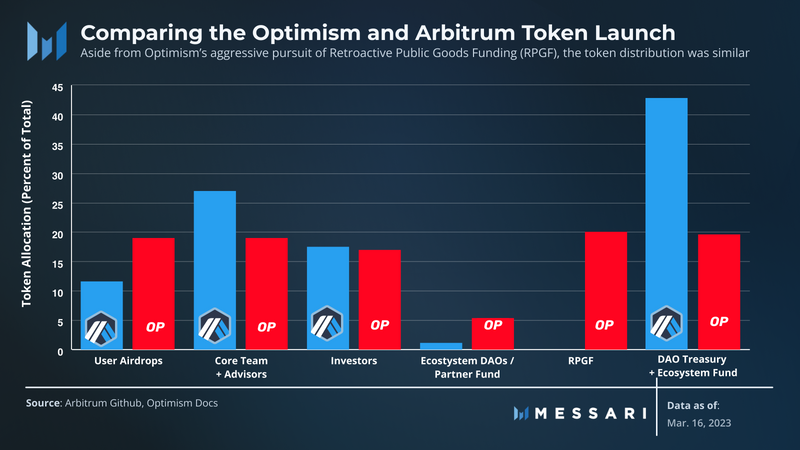
Arbitrum’s release plan also introduces some noticeable differences from Optimism’s launch, the starkest being its immediate dedication to on-chain governance. While Optimism continues to progress toward full on-chain governance, the current DAO still relies on the Optimism Foundation to execute the DAO’s wishes. In contrast, Arbitrum is self-executing out of the box, without relying on Offchain Labs or the Arbitrum Foundation to execute decisions.
As Optimism continues to decentralize, it will need to install several safeguards. For example, Arbitrum’s Security Council is a powerful example of how on-chain governance safeguards are critical security points. The Security Council maintains some level of control over nearly every critical contract.
On the other hand, Optimism and Arbitrum governance share a common focus on keeping delegates as stewards of the protocol. Optimism is already home to a powerful delegate ecosystem and features one of the best UIs for delegation in the entire space. During a recent Twitter Space, the Offchain Labs team expressed similar sentiments, stating that they’ve encouraged all core teams and advisors to delegate their holdings to community members and abstain from voting on proposals directly.
Conclusion
The launch of the Arbitrum DAO and the ARB token is another massive step forward for the decentralization of Layer-2 scaling solutions. Additionally, the L2 governance module accompanying Arbitrum governance is a massive step forward for governance.
While the token distribution follows that of Optimism, Arbitrum puts more tokens under the direct control of DAO voters.
In the coming week, delegates will begin applying to receive delegation. Once the token is launched, we will gain more insight into the governance landscape. Following the initial token distribution, the DAO’s first step will be to ratify the formation of the Arbitrum Foundation, Arbitrum DAO Constitution, Security and Data Availability Councils, DAO treasury funding, and AIP process as outlined within AIP-1.
Comparing the results of Arbitrum’s governance rollout with Optimism’s will offer valuable insights for future Layer-2 solutions aspiring to roll out their governance models.

